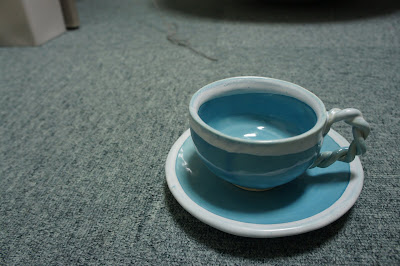Spa World in Osaka!
Anette
2:09:00 PM
Yuma and a statue by the entrance to Spa World
On Saturday me, Yuma, Silke and Bano went to Osaka to spend the day in a place called Spa World not that far from Osaka Bay.
The entrance fee for Spa World normally costs between 2400-2700 yen for three hours, but right now they have a campaign going on so that you can enter the place for only 1000 yen and stay there for about as many hours as you´d like. This campaign lasts out March, so if you are in the area you should definitely go ahead while you have the chance;)
The four of us in front of the entrance to Spa World. I guess the guy we asked to take the photo wasn't exacly a photographer, but after all I´m just glad he didn't run of with my camera cause he seemed a bit shady.. heheemm..
Spa World actually consists of 6 floors; in the basement they have a relaxation room, then the first floor is the reception area. Then there is one floor for the European style baths, one for the Asian style baths, in addition to a floor where there are restaurants and a floor with normal pool area (water slides etc). If you want to exercise they actually has a gym as well!
This month the European style baths was open only to women, and the Asian style baths only to men. This is something that changes every month though, so if you go again at another month you can experience totally new surroundings..
A picture I took of the pool area. Unlike the European and Asian styled baths, the pool area is open for everybody independent of gender.
Here they also have two water slides, but you have to pay additionally 300 yen each time you use them. Me and Yuma tried out one of them once though, and it was great!
In the third floor they have a restaurant area with a wide selection of food. That is to say, you don´t get much for your money so I recommend bringing your own lunch. Note our typical Spa World clothes by the way! They kinda looks like they were made for prisoners, haha:)
In the third floor they also has a Fish Therapy bath where you can let the small fishes eat on your toes for the neat price of 1050 yen. Woho! :P.. Kind of interesting though, I might have wanted to tried it if it was cheaper..
Poor things, they probably don´t get much food..
I couldn´t really bring my camera inside the European spa area, so I´ve copied some of the pictures from Spa World´s internet page instead.
The Roman style bath
The greek styled bath
..and one with inspiration from Finland.
Finally, the view of Tsutenkaku Tower seen from outside Spa World.
We arrived at Spa World there at 12 in the afternoon and left around 6 in the evening, and still I would have liked to stay there longer. I am definitely going back next month to try out the Asian style baths..!!
UPDATE: Spa World is still running an 1000-yen entrance campaign, at least out December 2011. But for some reason they don't write about this in their English page, it is only written in Japanese.. However, non-Japanese also get to enter for the same price.
Related blogposts
- All blogposts from Osaka
- Trip to Osaka: The German Christmas market
- Spa World in Osaka!
- Daytrip to Osaka!
- Hanami in the Expo ’70 Commemorative Park!
- I'm gonna be a Fuku Musume (福娘)!
- 第60回福娘発表会 The Daihyou Fuku Musume-Election
- Fukumusume (福娘): Behind the Scene of Osaka's Touka Ebisu Festival (十日戎)
- Day 1 of the Tōka-Ebisu Festival!
- The Fukumusume TV-Show 2012 福娘2012年
- Fukumusume (福娘): The Children's Ebisu Festival 子供戎祭
- Working as a Fukumusume (福娘): The Tōka Ebisu Festival (十日戎) 2013
- Fukumusume (福娘): Working at the Tōka Ebisu Festival (十日戎) 2015
- 第15回Fuku Musume 同窓会 in Osaka!
- 商売繁盛で笹持ってこい!Behind the scene of the Toka Ebisu Festival 2016
- All blogposts about hotels
- All blogposts about hotels / ryokan in Japan
- Tokyo Hotel Special: 2015 & 2016 Brand New Tokyo Hotels
- Lodging in Tokyo: 10 Unique Budget Hotels for an Unforgettable Stay
- All blogposts from Japan















































 A so-called Shimekazari, which is hanged by/on the door to bring good omen.
A so-called Shimekazari, which is hanged by/on the door to bring good omen. On the second of January we went to a hotspring with the funny name Pokapoka Onsen..! This was my second time visiting a Japanese hotspring so I didn´t have that much to compare with, but it was really great. Besides the usual Onsen-style they had some different types of saunas as well. Absolutely worth a visit!
On the second of January we went to a hotspring with the funny name Pokapoka Onsen..! This was my second time visiting a Japanese hotspring so I didn´t have that much to compare with, but it was really great. Besides the usual Onsen-style they had some different types of saunas as well. Absolutely worth a visit!


















